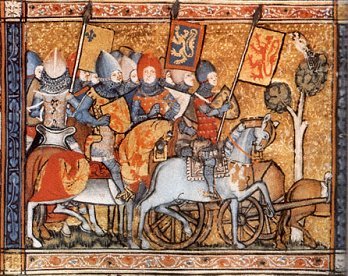
Hunting in the Middle Ages was very much a male preserve, except in one area. Women could attend a hunt on horseback, but they were usually there to flirt (or more) with the hunters, who were exclusively male. There was a great deal of sexual imagery used in writing about hunting and in some of the customs associated with it.
It was in hawking, however, that women found their own way to enjoy a hunt.
Hunting in the fourteenth century was not a sport, but a necessity. People hunted in order to eat. All strata of society hunted, from the king to the lowliest peasant. The main difference between them was that the king could hunt whatever he liked and wherever he liked, while the peasant was, in theory, very restricted, unless he was prepared to poach, which he usually was.
Hawking allowed women to show their riding skills without having to participate in the fast chase necessitated by hunting a stag. It was also much less bloody. It was the bird that made the kill, not the huntswoman. Aristocratic young women were expected to be able to hunt with birds in the same way that they were supposed to be able to play chess, tell stories, make witty conversation, sing and play a musical instrument. It was part of their education.
Ducks and herons were favourite prey for women. Their dogs would disturb them so that they flew up from the water and the huntswoman would loose her bird at them.
Hawking was tremendously expensive, so it was something that only the aristocracy could do properly, although lower classes could and did keep birds for hunting. The birds themselves cost a great deal and could travel a long way when they changed hands. They needed proper accommodation and training and exercise, which meant a falconer (usually very well paid) and his assistants had to be employed.
The birds most used in England were peregrines, merlins and hobbies. They were called ‘hawks of the fist’, because they were trained to return to the fist of the hunter instead of to a lure (something designed to make the bird think it was prey, usually a piece of meat and some feathers). The lure would be swung to make the bird think it was in flight and she would try to catch it. These were also used in training the birds. Merlins were generally considered suitable birds for women. Female birds were used by both men and women, as they are larger than the males.
Rosamunde, the heroine of my novel His Ransom is clearly an aristocratic young woman who likes to hunt. Before her betrothed went to fight in France she joined him in a stag hunt, and a hawking expedition later in the novel leads her into great danger.
It’s difficult to overstate how important hunting was in the Middle Ages. For many it was the difference between life and death.




